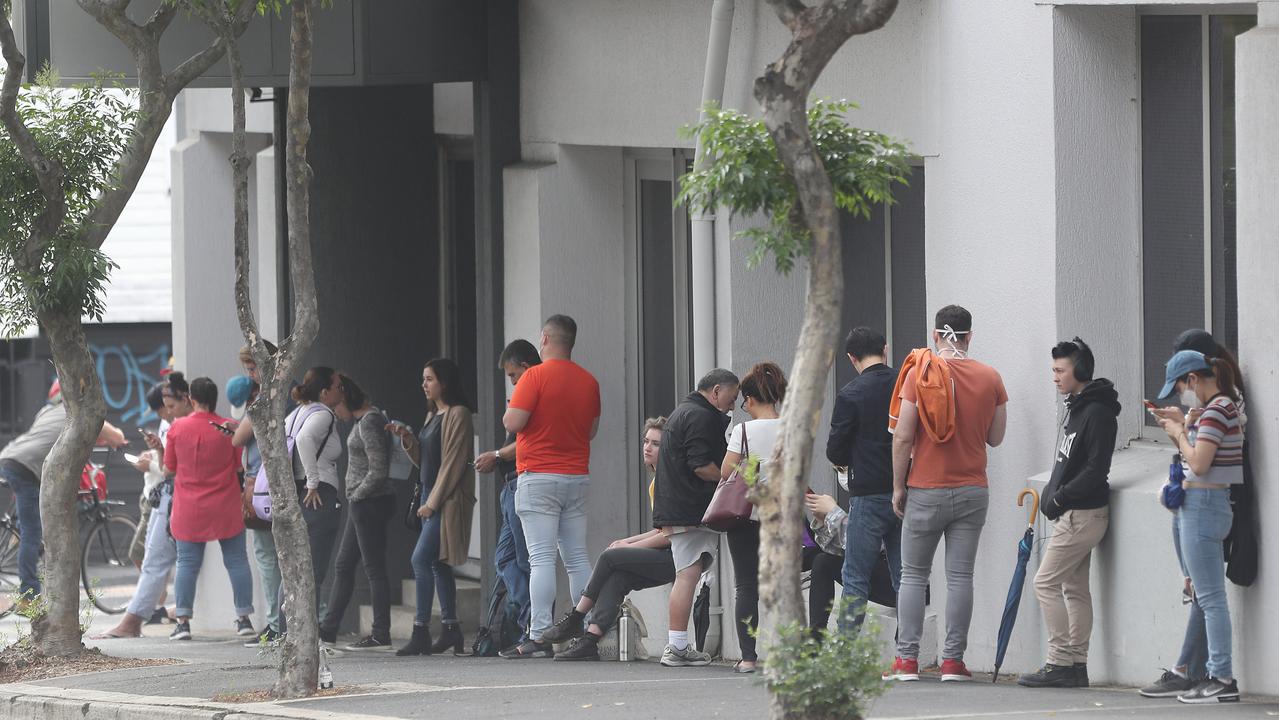Up to 250,000 jobs could be lost as JobKeeper ends
Up to a quarter of a million Aussies could lose their jobs in a wave of business collapses beginning within weeks, new analysis has warned.

Up to a quarter of a million Aussies could lose their jobs in a wave of business collapses as JobKeeper ends this month, experts have warned.
The Federal Government will finally pull the plug on its $90 billion wage subsidy scheme on March 28, as the Australian economy begins to stand on its own two feet after the devastation caused by COVID-19 lockdowns.
But a leading labour market economist warns that the withdrawal of the wage subsidy will wipe out thousands of businesses that until now had been kept afloat by the scheme.
“My best guesstimate is that 125,000 to 250,000 persons might lose work when the program finishes at the end of March,” Professor Jeff Borland from the University of Melbourne wrote in his labour market snapshot on Wednesday.
Prof Borland stresses that forecasting potential JobKeeper job losses is extremely difficult.
“Suppose that the number of JobKeeper recipients stayed at 1.55 million (the most recent available figure as of December 1), that the proportion of revenue lost by business receiving JobKeeper was 35 per cent, and that the number of unviable jobs is in proportion to revenue decreases,” he wrote.
“This would suggest employment losses could be 550,000 persons.”
But that number “needs to be treated as a pretty unlikely upper bound,” he said.
“It doesn’t take too much to change for the number to look more like my guesstimate based on the (Australian Bureau of Statistics’ Labour Force Survey) data. For example, if the average revenue loss of business receiving JobKeeper was only 15 per cent by end of March, it would mean 235,000 persons would lose employment.”
Prof Borland told news.com.au while his analysis was “rudimentary”, it was an important topic for policy and there “hadn’t been much commentary on it”.
It comes as Nine Newspapers notes that, based on a review of Australian Securities and Investments Commission notices, just three companies have used the Federal Government’s new insolvency processes designed to help financially struggling but otherwise viable small businesses stay afloat.

CreditorWatch chief executive Patrick Coghlan told news.com.au that based on historical insolvency trends comparing the number that took place in 2020 versus 2019, there would likely be at least 3000 to 4000 businesses that go under after March.
Last year 4943 companies entered administration, or about half the normal number.
“There will definitely be a shock come end of JobKeeper,” he said, but added he did not think it would be the “tsunami of insolvencies” originally predicted at the start of the pandemic.
“There is definitely going to be a bit of a reset given there were thousands of companies that didn’t go into administration that would have in a standard year. That 3000 to 4000 is just companies that go into administration in a normal year – I think there are (going to be) COVID-affected administrations on top of that.”
But Mr Coghlan said it was difficult to predict what the additional number of purely COVID-related administrations would be.
He said we was “not expecting them all to happen in April”.
“I still think it will be a gradual increase back up to pre-COVID levels … but I think it’s a logical conclusion that there were companies that would have gone into administration that haven’t, and companies that were affected by COVID,” he said.
Mr Coghlan said JobKeeper had been a “fantastic policy initiative” that had saved “hundreds of thousands, if not millions of jobs”, but it was time for it to end.
“I’m very hopeful that come April the economy’s in a much better position, hopefully no lockdowns, people are getting out there, restrictions being eased and money being spent,” he said.
“If you extend (JobKeeper) you start to potentially cause more issues, because there are companies out there that need to be allowed to fail.”
One unknown factor, Mr Coghlan said, was how aggressive ASIC and the Australian Taxation Office would be in enforcement.

Chris Baskerville, partner at insolvency firm Jirsch Sutherland, agreed.
“The big unknown in all this, the sleeping giant, is the ATO,” he said.
“We’re starting to now see creditors filing for winding up of companies. We even saw an ATO wind-up which we all got semi-excited about, but it was only one. We’ve seen 17 companies apply for temporary restructuring relief. Personally I’ve had more inquiries in January than I almost did for the entire period of October, November, December.”
Mr Baskerville said the government stimulus had been sweeping.
“They basically paid for our staff wages, they got reprieve and abatement from our landlords, we got back our taxes to a certain extent, creditors practically couldn’t sue a director, the ATO stopped enforcing and the banks did the same, they just navigated and pushed people through to the new year,” he said.
“Obviously now there’s a rollback period – JobKeeper’s rolling back, there’s no way we’re going to get any more taxes back, landlords now want their money and the banks will soon be asking for their money.”
As for which industries will be affected, Mr Baskerville predicts insolvencies will start to rise “in the exact order they were impacted last year”.
“Personally I’m currently trading six gyms, all of them have got landlord problems, franchisor problems, trying to recover from the pandemic and they just couldn’t get on top of the debts,” he said.
“I think we’re starting to see hospitality and food retail take a bit of a hit.”
Indeed, one food retailer last month announced that it would be shutting up shop the minute JobKeeper ends.
Paul Siderovski, owner of Newscastle-based chain Yoghurt Land, said he would be permanently closing his 11 stores at the end of this month, putting about 200 people out of work.
He told the Newcastle Herald the decision was “heartbreaking”.
“In spite of the best efforts of all staff, we are no longer able to move forward into the future, with sales being down over 30 per cent due to COVID-19,” he said.

A spokesman for Treasurer Josh Frydenberg referred news.com.au to his February 24 speech to the Australian Chamber of Commerce and Industry.
“Together with those that transitioned off the first phase of program, this shows that around 2.7 million individuals across around 650,000 businesses have now graduated from JobKeeper,” Mr Frydenberg said.
“As a result Treasury now expects the number of individuals relying on the payment to be 1.1 million in the March quarter – a reduction of 200,000 compared to the MYEFO estimate of 1.3 million. Of the 1.1 million people expected to be on JobKeeper in the March quarter, we are expecting the overwhelming majority to remain in their existing jobs following the conclusion of the program.”
In that speech, the Treasurer noted this was supported by the Reserve Bank, “which is forecasting that the unemployment rate will continue to fall from 6.4 per cent in January to reach 6 per cent by the year’s end”.
Treasury has estimated about 100,000 jobs could be lost when JobKeeper ends but the Federal Government has previously said record levels of household and business savings amassed during the pandemic would drive the recovery.
Mr Frydenberg said in January the Coalition’s economic parachute had ensured Australia avoided an economic catastrophe.
“The unprecedented economic support provided by the Morrison Government during the crisis means that, even as JobKeeper and other temporary emergency support measures taper off, a fiscal cliff is avoided,” he said.
“With an additional $200 billion sitting on household and business balance sheets compared to the start of last year, there is a huge sum of money available to be spent across the economy helping to create jobs and maintain the momentum of our economic recovery.”
Labor had called for JobKeeper to be extended past March, arguing hospitality and tourism were lagging behind other sectors.
The big question is whether there will be a soft landing, or if the can has simply been kicked down the road.
Mr Baskerville notes that during the GFC, it took effectively a full year – from the beginning of 2008 to early 2009 – before it really “hit the fan” and the full effects were seen.
“I guess if we have been stimulating the economy right up until March 28, one thought is we pretty much have to wait a year until you see the full effect,” he said.
“I don’t think we’re going to get the cliff, the tsunami I was predicting – I think the Government has stimulated the economy enough to avoid that – but I think we’ll start to see a ramp-up potentially towards the end of this year.”
He added: “I just can’t help but think we haven’t seen the full negative impact of the pandemic. We’re still waiting.”
– with NCA NewsWire




